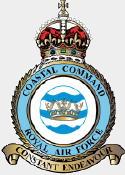Corgi AA33303 RAF Boeing B-17 IIA Flying Fortress Heavy Bomber - FL459, No. 220 Squadron, RAF Coastal Command, Ballykelly, Northern Ireland, 1942 (1:72 Scale)
"Why should we have a navy at all? There are no enemies for it to fight except apparently the Army Air Force."
- General Carl Spaatz, Commander of the US 8th Army Air Force, after WWII
 The B-17, arguably World War II's most famous heavy bomber, first flew on July 28th, 1935, before a crowd of reporters eager to see Boeing's new bomber take wing. It was dubbed the "Flying Fortress" by the members of the press in attendance because of its (at least for the time) heavy defensive armament. The prototype crashed in October, but because of its impressive speed and handling the US Army Air Corps (USAAC) decided to continue testing anyway. They ordered 13 YB-17s for further evaluation, a decision that would prove momentous in years to come.
The B-17, arguably World War II's most famous heavy bomber, first flew on July 28th, 1935, before a crowd of reporters eager to see Boeing's new bomber take wing. It was dubbed the "Flying Fortress" by the members of the press in attendance because of its (at least for the time) heavy defensive armament. The prototype crashed in October, but because of its impressive speed and handling the US Army Air Corps (USAAC) decided to continue testing anyway. They ordered 13 YB-17s for further evaluation, a decision that would prove momentous in years to come.
The YB-17 had five machine guns, room for 4,800 pounds of bombs and a crew of nine. It had electrically retractable landing gear. After testing the YB-17, an improved prototype, the Y1B-17, was built with Wright Cyclone radial engines. Twelve were delivered to the USAAC's 2nd Bombardment Group for trials. One of these was soon equipped with new Moss/General Electric turbochargers that became standard on all future Flying Fortresses. The first production order was for 39 B-17Bs with turbo-charged engines, and as soon as these were under production another order for the B-17C was placed, with seven machine guns instead of the original five.
The RAF received their first B-17Cs in 1941, and were soon conducting daylight raids over Germany. The defensive armament soon proved inadequate, and the B-17's altitude was little defense against the German fighters. Orders for the B-17D were soon placed with self-sealing fuel tanks and more armor because of lessons learned in bombing missions over Europe. The B-17E and B-17F soon followed with larger tail. The B-17F was the first to serve with the USAAF 8th Air Force. After suffering staggering losses in late 1943, analysis proved head-on attacks by enemy fighters were a distinct problem. The final major version, the B-17G, added a chin turret with dual machineguns. This gave the B-17 a defensive armament of 13 guns.
After the war, several dozen B-17s lived on as fire-bombers and aerial surveyors until the last one was retired in the 1970s. Today, a few B-17s have been restored to their wartime splendor. Ten are currently flying in the United States, one in the UK and another one in France.
Pictured here is a 1:72 scale replica of a RAF Boeing B-17 IIA Flying Fortress heavy bomber that was attached to No. 220 Squadron, RAF Coastal Command, then deployed to Ballykelly, Northern Ireland, during 1942. Features extremely high level of details including full crew, rotating gun turrets, working undercarriage, and bomb load.
Sold Out!
Dimensions:
Wingspan: 17-1/2-inches
Length: 12-1/4-inches
Release Date: 2007
 Historical Account: "Constant Endeavour" - During the buildup to the Second World War, No. 220 Squadron reformed at RAF Bircham Newton in 1936 as a reconnaissance squadron flying Ansons. With the outbreak of war it flew patrols from RAF Thornaby as part of No. 18 Group, transitioning to Hudsons in November; it flew anti-shipping missions with these in the North Sea from May 1940 onwards. In April 1941, still in the anti-shipping role, it moved to RAF Wick to fly strikes against Norwegian coastal traffic, and began to operate the Fortress in November. In February 1942 it moved to RAF Nutts Corner under No. 15 Group, then to RAF Ballykelly in June; in March 1943 it transferred to RAF Benbecula in the Outer Hebrides. Detachments operated from RAF Bircham Newton, RAF St Eval and RAF Detling in 1940, and from RAF Shallufa in Egypt in early 1942.
Historical Account: "Constant Endeavour" - During the buildup to the Second World War, No. 220 Squadron reformed at RAF Bircham Newton in 1936 as a reconnaissance squadron flying Ansons. With the outbreak of war it flew patrols from RAF Thornaby as part of No. 18 Group, transitioning to Hudsons in November; it flew anti-shipping missions with these in the North Sea from May 1940 onwards. In April 1941, still in the anti-shipping role, it moved to RAF Wick to fly strikes against Norwegian coastal traffic, and began to operate the Fortress in November. In February 1942 it moved to RAF Nutts Corner under No. 15 Group, then to RAF Ballykelly in June; in March 1943 it transferred to RAF Benbecula in the Outer Hebrides. Detachments operated from RAF Bircham Newton, RAF St Eval and RAF Detling in 1940, and from RAF Shallufa in Egypt in early 1942.
In October 1943, the squadron was moved to RAF Lagens, in the Azores Islands, where it came under No. 247 Group and, in December 1944, was re-equipped with Liberators. From 1943 until the end of the war the squadron flew anti-submarine patrols across the South Atlantic.
In June 1945, the squadron returned to the UK as part of Transport Command, and flew troop flights to India from October 1945 to April 1946. After this final service, the squadron was disbanded in May 1946.


